The Health Education Assets Library (HEAL) is a collection of over 22,000 freely available digital materials for health sciences education. The collection is now housed at the University of Utah J. Willard Marriott Digital Library.
TO
Filters: Collection: "ehsl_heal"
| Title | Description | Subject | Collection | ||
|---|---|---|---|---|---|
| 276 |
 |
Coordination Exam: Anatomy: Midline Ataxia (x2) (includes Spanish audio & captions) | Clinically, the ataxic syndromes caused by vestibulocerebellar and spinocerebellar disease are lumped together and are called midline or equilibratory (gait) ataxias. The hallmarks of these midline ataxic syndromes are truncal instability manifested by titubation (tremor of the trunk in an anterior-... | Coordination Examination; Anterior Lobe of Cerebellum; Flocculonodular Lobe | NeuroLogic Exam: An Anatomical Approach |
| 277 |
 |
Coordination Exam: Abnormal Examples: Tremor (includes Spanish audio & captions) | A cerebellar intention tremor (1st scene in this movie) arises mainly from limb girdle muscles and is maximal at the most demanding phase of the active movement. This must be distinguished from a postural tremor (fine distal 8-13 Hz)(2nd scene) or resting tremor (coarse distal 5-6 Hz pill-rolling ty... | Coordination Examination; Intention Tremor; Static Tremor; Resting Tremor | NeuroLogic Exam: An Anatomical Approach |
| 278 |
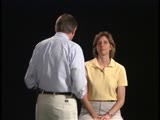 |
Cranial Nerve Exam: Normal Exam: Vergence (x2) | Vergence eye movements occur when the eyes move simultaneously inward (convergence) or outward (divergence) in order to maintain the image on the fovea that is close up or far away. Most often convergence is tested as part of the near triad. When a patient is asked to follow an object that is brough... | Cranial Nerve Examination; Vergence | NeuroLogic Exam: An Anatomical Approach |
| 279 |
 |
Cranial Nerve Exam: Abnormal Examples: Optokinetic Nystagmus | This patient has poor optokinetic nystagmus when the tape is moved to the right or left. The patient lacks the input from the parietal-occipital gaze centers to initiate smooth pursuit movements therefore her visual tracking of the objects on the tape is inconsistent and erratic. Patients who have a... | Cranial Nerve Examination | NeuroLogic Exam: An Anatomical Approach |
| 280 |
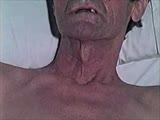 |
Cranial Nerve Exam: Abnormal Examples: Cranial Nerve 11 - Motor (x2) | When the patient contracts the muscles of the neck the left sternocleidomastoid muscle is easily seen but the right is absent. Looking at the back of the patient, the left trapezius muscle is outlined and present but the right is atrophic and hard to identify. These findings indicate a lesion of the... | Cranial Nerve Examination | NeuroLogic Exam: An Anatomical Approach |
| 281 |
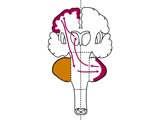 |
Coordination Exam: Anatomy: Cerebrocerebellum (includes Spanish audio & captions) | The 3rd subdivision of the cerebellum is the cerebrocerebellum. This system consists of connections from the cerebral cortex (predominantly motor) to the cerebellar hemispheres then back to the cerebral cortex. This system is important in motor planning. Dysfunction of the cerebellar hemispheres res... | Coordination Examination | NeuroLogic Exam: An Anatomical Approach |
| 282 |
 |
Gait Exam: Anatomy: Localizing Value | There are 7 basic pathological gaits that should be recognized by their characteristic pattern. These pathological gaits are: - Hemiplegic - Spastic diplegic - Neuropathic - Myopathic - Parkinsonian - Chorea - Ataxic These gaits have localizing value because they can indicate levels (an y axis a... | Gait Examination; Hemiplegic Gait; Spastic Diplegia; Neuropathic Gait; Myopathic Gait; Diplegic Gait | NeuroLogic Exam: An Anatomical Approach |
| 283 |
 |
Coordination Exam: Abnormal Examples: Tremor (x2) (includes Spanish audio & captions) | A cerebellar intention tremor (1st scene in this movie) arises mainly from limb girdle muscles and is maximal at the most demanding phase of the active movement. This must be distinguished from a postural tremor (fine distal 8-13 Hz)(2nd scene) or resting tremor (coarse distal 5-6 Hz pill-rolling ty... | Coordination Examination; Intention Tremor; Static Tremor; Resting Tremor | NeuroLogic Exam: An Anatomical Approach |
| 284 |
 |
Cranial Nerve Exam: Abnormal Examples: Cranial Nerve 2 - Fundoscopy | The first photograph is of a fundus showing papilledema. The findings of papilledema include 1. Loss of venous pulsations 2. Swelling of the optic nerve head so there is loss of the disc margin 3. Venous engorgement 4. Disc hyperemia 5. Loss of the physiologic cup and 6. Flame shaped hemorrhages. Th... | Cranial Nerve Examination | NeuroLogic Exam: An Anatomical Approach |
| 285 |
 |
Cranial Nerve Exam: Abnormal Examples: Cranial Nerves 2 & 3 - Pupillary Light Reflex | The swinging flashlight test is used to show a relative afferent pupillary defect or a Marcus Gunn pupil of the left eye. The left eye has perceived less light stimulus (a defect in the sensory or afferent pathway) then the opposite eye so the pupil dilates with the same light stimulus that caused c... | Cranial Nerve Examination; Marcus Gunn Pupil | NeuroLogic Exam: An Anatomical Approach |
| 286 |
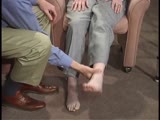 |
Coordination Exam: Abnormal Examples: Heel-to-shin (includes Spanish audio & captions) | The patient with ataxia of the lower extremity will have difficulty placing the heel on the knee with a side-to-side irregular over- and undershooting as the heel is advanced down the shin. Dysmetria on heel-to-shin can be seen in midline ataxia syndromes as well as cerebellar hemisphere disease so ... | Coordination Examination; Heel-shin Test | NeuroLogic Exam: An Anatomical Approach |
| 287 |
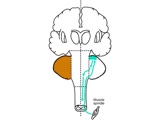 |
Coordination Exam: Anatomy: Spinocerebellum (x2) (includes Spanish audio & captions) | The 2nd subdivision of the cerebellum is the spinocerebellum. This system consists of the connections between the cutaneous and proprioceptive information coming from the spinal cord to the vermis and paravermis regions with corrective feedback predominantly to the muscles of truncal stability and g... | Coordination Examination; Anterior Lobe of Cerebellum; Spinocerebellum | NeuroLogic Exam: An Anatomical Approach |
| 288 |
 |
Coordination Exam: Anatomy: Spinocerebellum (includes Spanish audio & captions) | The 2nd subdivision of the cerebellum is the spinocerebellum. This system consists of the connections between the cutaneous and proprioceptive information coming from the spinal cord to the vermis and paravermis regions with corrective feedback predominantly to the muscles of truncal stability and g... | Coordination Examination; Anterior Lobe of Cerebellum; Spinocerebellum | NeuroLogic Exam: An Anatomical Approach |
| 289 |
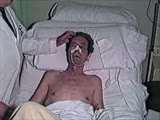 |
Cranial Nerve Exam: Abnormal Examples: Cranial Nerve 7 - Motor (x2) | The first patient has weakness of all the muscles of facial expression on the right side of the face indicating a lesion of the facial nucleus or the peripheral 7th nerve. The second patient has weakness of the lower half of his left face including the orbicularis oculi muscle but sparing the forehe... | NeuroLogic Exam: An Anatomical Approach | |
| 290 |
 |
Cranial Nerve Exam: Abnormal Examples: Cranial Nerve 2 - Fundoscopy (x2) | The first photograph is of a fundus showing papilledema. The findings of papilledema include 1. Loss of venous pulsations 2. Swelling of the optic nerve head so there is loss of the disc margin 3. Venous engorgement 4. Disc hyperemia 5. Loss of the physiologic cup and 6. Flame shaped hemorrhages. Th... | Cranial Nerve Examination | NeuroLogic Exam: An Anatomical Approach |
| 291 |
 |
Cranial Nerve Exam: Normal Exam: Vergence | Vergence eye movements occur when the eyes move simultaneously inward (convergence) or outward (divergence) in order to maintain the image on the fovea that is close up or far away. Most often convergence is tested as part of the near triad. When a patient is asked to follow an object that is brough... | Cranial Nerve Examination; Vergence | NeuroLogic Exam: An Anatomical Approach |
| 292 |
 |
Cranial Nerve Exam: Abnormal Examples: Cranial Nerve 7 - Motor | The first patient has weakness of all the muscles of facial expression on the right side of the face indicating a lesion of the facial nucleus or the peripheral 7th nerve. The second patient has weakness of the lower half of his left face including the orbicularis oculi muscle but sparing the forehe... | NeuroLogic Exam: An Anatomical Approach | |
| 293 |
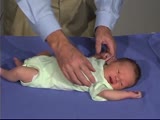 |
PediNeuroLogic Exam: Newborn: Normal: Tone - Arm Recoil (x2) | Arm recoil tests tone and action of the biceps. The arms are held in flexion against the chest for a few seconds, then are quickly extended and released. The arms should spring back to the flexed position. The hypotonic infant will have slow incomplete recoil. Asymmetry to this response with lack of... | PediNeuroLogic Exam | |
| 294 |
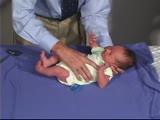 |
PediNeuroLogic Exam: Newborn: Normal: Primitive Reflexes - Galant | The Galant reflex (trunk incurvation) is obtained by placing the baby in ventral suspension, then stroking the skin on one side of the back. The baby's trunk and hips should swing towards the side of the stimulus. PediNeuroLogic Exam has been supported by a grant from the Slice of Life Developmen... | PediNeuroLogic Exam | |
| 295 |
 |
Aortocaval Fistula (Labeled) | Fistula between aorta and inferior vena cava. | Aortocaval Fistula | Royal College of Surgeons in Ireland Illustrations |
| 296 |
 |
Resection and Primary Anastomosis of Sigmoid Colon (Labeled) | Colon resection. Primary anastomosis. | Primary Anastomosis; Resection | Royal College of Surgeons in Ireland Illustrations |
| 297 |
 |
Mastectomy - Right Breast | Breast cancer. Incision site. Mastectomy. | Incision Site; Breast Cancer | Royal College of Surgeons in Ireland Illustrations |
| 298 |
 |
Coordination Exam: Abnormal Examples: Heel-to-shin (x2) (includes Spanish audio & captions) | The patient with ataxia of the lower extremity will have difficulty placing the heel on the knee with a side-to-side irregular over- and undershooting as the heel is advanced down the shin. Dysmetria on heel-to-shin can be seen in midline ataxia syndromes as well as cerebellar hemisphere disease so ... | Coordination Examination; Heel-shin Test | NeuroLogic Exam: An Anatomical Approach |
| 299 |
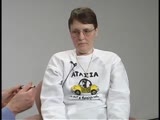 |
Coordination Exam: Abnormal Examples: Finger-to-nose (x2) (includes Spanish audio & captions) | Under (hypometria) and over (hypermetria) shooting of a target (dysmetria) and the decomposition of movement (the breakdown of the movement into its parts with impaired timing and integration of muscle activity) are seen with appendicular ataxia. NeuroLogic Exam has been supported by a grant from th... | Coordination Examination; Finger-to-nose Test | NeuroLogic Exam: An Anatomical Approach |
| 300 |
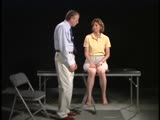 |
Coordination Exam: Normal Exam: Finger-to-nose (includes Spanish audio & captions) | The patient moves her pointer finger from her nose to the examiner's finger as the examiner moves his finger to new positions and tests accuracy at the furthest outreach of the arm. NeuroLogic Exam has been supported by a grant from the Slice of Life Development Fund at the University of Utah, th... | Coordination Examination; Finger-to-nose Test | NeuroLogic Exam: An Anatomical Approach |
